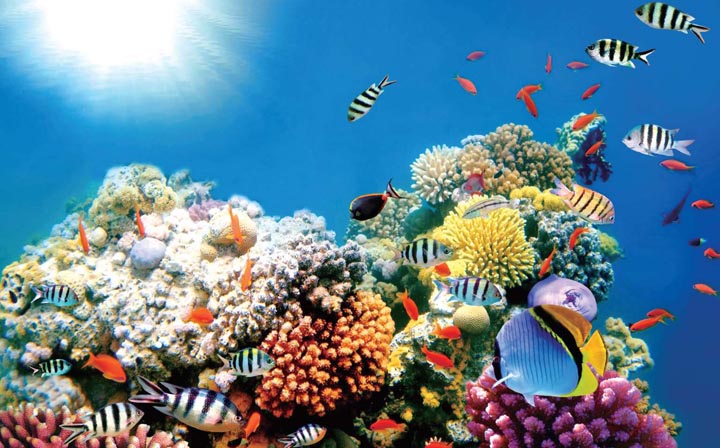




Coral reefs are very beautiful, natural structures. The various types of coral are very colourful because of natural pigments. They can be white, red, pink, purple, and many other colours. These amazing creatures are animals that act like plants. Similar to plants, they stay in one place and receive their energy from the Sun. A kind of microscopic algae lives inside of coral, providing it with food and allowing it to grow faster.
Most coral reefs are found in clear, tropical oceans in water less than 50 metres deep. This is due to the fact that they need light in order to survive. The three main types of coral reef are: fringing reefs, barrier reefs, and atolls.

Fringing reefs grow along the coastal shorelines of continents and islands. There are many of them in Hawaii and the Caribbean. Barrier reefs, on the other hand, are found offshore in the Caribbean and the Indo-Pacific. They are a series of shallow coral islands that surround a lagoon. Australia is home to the largest coral reef in the world. The Great Barrier Reef extends over 2000 kilometres.
The water in coral reef ecosystems is between 20 and 28 degrees Celsius and usually along the eastern coasts of land. Waves are very important to the health of coral reefs. They bring in food and nutrients to coral reefs. They also stop sediment from settling on the reef.
The plants that flourish in coral reefs grow because of the process of photosynthesis. And the same as on dry land, the animals of the coral reefs get their energy by eating the plants.
Amazingly, coral reefs make up only 1% of the ocean floor, but they are home to 25% of the life in the ocean!
Coral reefs are helpful to the planet. They remove and recycle carbon dioxide from the air, which can contribute to global warming. They also protect the land from large waves when the weather is very stormy. Unfortunately, pollution, overfi shing, and sewage are responsible for the destruction of many coral reefs.
Word List
pigment : the natural colouring of animal or plant tissue
lagoon : a body of water surrounded by water on three sides
fl ourish : to do very well
sewage : human waste matter that comes from sewers
You Practice
I. Answer the following questions.
1) What are three interesting things about coral reefs?
2) What are the three main types of coral reefs?
3) Why are coral reefs found in shallow waters?
4) What is a similarity between fringing reefs and barrier reefs?
5) In what way are coral reefs good for the Earth?
II. Word power—Use these words from the reading in sentences of your own.
1) pigment ______________________________________________
2) microscopic ___________________________________________
3) offshore ______________________________________________
4) lagoon _______________________________________________
5) pollution ______________________________________________
III. True / False / Not Given—Write T if the sentence is true, F if it is not true, or NG if there is no information about this sentence.
____ 1) Coral reefs are home to an amazing amount of life.
____ 2) Coral reefs grow in cold water.
____ 3) Some coral reefs are threatened because of human activities.
____ 4) The Caribbean is home to more than one kind of coral reef.
____ 5) Fringing reefs are found far from land.